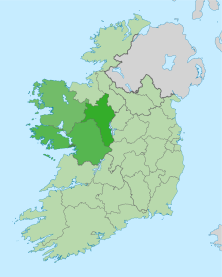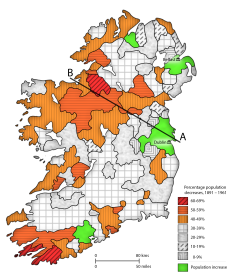👉 Find out about The Open University's Geography courses. 👈
Explore the articles in this collection
-
Change in the West of Ireland
Read now to access more details of Change in the West of IrelandIntroducing a collection of articles asking 'How can unique and distinctive regions, like the West of Ireland, retain the qualities that make them unique while continuing to modernise and interact with the wider world?'

Article
-
Synthesis as a way of understanding the changing uniqueness of rural Ireland
Take part now to access more details of Synthesis as a way of understanding the changing uniqueness of rural IrelandWhat is synthesis? Discover how this way of thinking helps us to understand more about the way in which places retain their uniqueness within wider systems of interdependence.

Activity
-
The West of Ireland: Dimensions of distinctiveness
Read now to access more details of The West of Ireland: Dimensions of distinctivenessHow do you define 'the West of Ireland'? Do you look at cultural factors, geography, or something else?

Article
-
Culture and regional distinctiveness
Read now to access more details of Culture and regional distinctivenessCulture and how language identifies that culture are key to understanding what makes a region unique.

Article
-
The rural dimension – rundale in the West of Ireland
Read now to access more details of The rural dimension – rundale in the West of IrelandThe rundale system once governed how farmland was distributed between tenants in Ireland. It supposedly died out in the 19th century, but this was not actually the case in some parts of the West of Ireland.

Article
-
The rural dimension – after rundale
Watch now to access more details of The rural dimension – after rundaleHow did the rural areas of Western Ireland change after the rundale system was replaced?

Video
-
A changing uniqueness – The changing ‘place’ of the West
Read now to access more details of A changing uniqueness – The changing ‘place’ of the WestThe population of Western Ireland declined dramatically between 1891 and 1961. How do you think this affected Ireland as a whole?

Article
-
The realities of rural life in the 1950s-1980s
Watch now to access more details of The realities of rural life in the 1950s-1980sThe period of the 1950s to 1980s was the beginning of modernisation in community life and farming and the development of manufacturing industry in the West of Ireland.

Video
-
The dilemma of tourism and the Irish language, 1983
Watch now to access more details of The dilemma of tourism and the Irish language, 1983Father James McDyer discusses the dilemma of the Glencolmcille holiday village between development, language and culture and the threat of depopulation. Tourism is important for economic development but what impact does it have on local culture and the Irish language?

Video
-
A new layer: Culture, the Irish language and identity in 2015
Watch now to access more details of A new layer: Culture, the Irish language and identity in 2015We revisit the Glencolmcille folk village in 2015 to see whether the dilemma of development and the local language and culture has been resolved.

Video
-
Southwest Donegal: uniqueness and interdependence in 2015
Read now to access more details of Southwest Donegal: uniqueness and interdependence in 2015In Southwest Donegal, we see both the local uniqueness and different interdependencies and interconnections with other places.

Article
-
The future of rural Ireland - nuances, scale and fighting back
Read now to access more details of The future of rural Ireland - nuances, scale and fighting backThe future of rural Ireland - nuances, scale and fighting back

Article
When Pat Jess visited Southwest Donegal in 1983, the dilemma of culture and/or manufacturing industry was a live issue. The fight to retain a unique Irish-speaking culture meant that jobs had to be created locally in manufacturing and tourism so that Irish speakers no longer had to emigrate. But industrialisation also threatened the survival of the Irish language, because English is the language of industry and commerce and industrialisation and tourism had increased regular contact with the English-speaking outside world.To retain what was left of an Irish-speaking culture, employment was needed, and that meant bringing in manufacturing industry. But wouldn’t this undermine the unique culture still further? Would the cure kill the patient?
In the 1980s, the local synthesis of economy and culture was being reconstructed around four types of industrial development. These included local community initiatives with a cooperative or nonprofitmaking element, local private capital, multinational branch plants; and the state-owned enterprise which was under the remit of Údarás na Gaeltachta, an authority which had been established in 1980 and was responsible for the economic, social and cultural development of the Gaeltacht.
Cathal Mac Suibhne was the local representative of Údarás na Gaeltachta in 1983 (which is still in existence in 2015). Its overall objective is to ensure that Irish remains the main communal language of the Gaeltacht and is passed on to future generations. The authority endeavours to achieve that objective by funding and fostering a wide range of enterprise development and job creation initiatives, and by supporting strategic language, cultural and community based activities. The website for Údarás na Gaeltachta is www.udaras.ie.
Údarás owned the spinning and weaving factories in Kilcar, and through giving grants, training workers and managers and providing industrial premises, was involved in all four types of industrial development in the area.
Transcript: The problems of industrialisation in Southwest Donegal in 1983
[Cèilidh music]
PAT JESS
Although Southwest Donegal is economically disadvantaged by its relative remoteness, it’s culturally rich. With other residual pockets of Gaelic culture in the West of Ireland, this area is central to the survival of Irish as a living language.
Poverty and a lack of jobs led to decades of emigration which decimated the Irish speaking community. Agriculture, even modernised agriculture could not by itself stem the flow of emigration. To retain what was left of an Irish speaking culture, employment was needed, and that meant bringing in manufacturing industry. But wouldn’t this undermine the unique culture still further? Would the cure kill the patient?
In this programme we look at how the local synthesis of the economy and culture has been reconstructed around new types of industrial development. Cathal MacSuibhne is the local representative of Udaras Na Gaeltachta, the state authority charged with promoting industry in Irish speaking areas. What are the problems of industrialising in a peripheral region?
CATHAL MACSUIBHNE
Well the economic-based area was built on subsistence farming, small fishing, homecraft industries, which basically was very weak, supporting a lot of both young and elderly people. That base had to be developed by trying to promote returned emigrants who got their skills and obtained their skills abroad in England and Scotland and in the States, developing existing industries such as the tweed and the spinning here, promoting industries from outside the area that came in to give employment and that gives skills. It’s along those lines starting from a very weak base, trying to get marketable products, that is the exercise basically.
Explore the articles in this collection
-
Change in the West of Ireland
Read now to access more details of Change in the West of IrelandIntroducing a collection of articles asking 'How can unique and distinctive regions, like the West of Ireland, retain the qualities that make them unique while continuing to modernise and interact with the wider world?'

Article
-
Synthesis as a way of understanding the changing uniqueness of rural Ireland
Take part now to access more details of Synthesis as a way of understanding the changing uniqueness of rural IrelandWhat is synthesis? Discover how this way of thinking helps us to understand more about the way in which places retain their uniqueness within wider systems of interdependence.

Activity
-
The West of Ireland: Dimensions of distinctiveness
Read now to access more details of The West of Ireland: Dimensions of distinctivenessHow do you define 'the West of Ireland'? Do you look at cultural factors, geography, or something else?

Article
-
Culture and regional distinctiveness
Read now to access more details of Culture and regional distinctivenessCulture and how language identifies that culture are key to understanding what makes a region unique.

Article
-
The rural dimension – rundale in the West of Ireland
Read now to access more details of The rural dimension – rundale in the West of IrelandThe rundale system once governed how farmland was distributed between tenants in Ireland. It supposedly died out in the 19th century, but this was not actually the case in some parts of the West of Ireland.

Article
-
The rural dimension – after rundale
Watch now to access more details of The rural dimension – after rundaleHow did the rural areas of Western Ireland change after the rundale system was replaced?

Video
-
A changing uniqueness – The changing ‘place’ of the West
Read now to access more details of A changing uniqueness – The changing ‘place’ of the WestThe population of Western Ireland declined dramatically between 1891 and 1961. How do you think this affected Ireland as a whole?

Article
-
The realities of rural life in the 1950s-1980s
Watch now to access more details of The realities of rural life in the 1950s-1980sThe period of the 1950s to 1980s was the beginning of modernisation in community life and farming and the development of manufacturing industry in the West of Ireland.

Video
-
The dilemma of tourism and the Irish language, 1983
Watch now to access more details of The dilemma of tourism and the Irish language, 1983Father James McDyer discusses the dilemma of the Glencolmcille holiday village between development, language and culture and the threat of depopulation. Tourism is important for economic development but what impact does it have on local culture and the Irish language?

Video
-
A new layer: Culture, the Irish language and identity in 2015
Watch now to access more details of A new layer: Culture, the Irish language and identity in 2015We revisit the Glencolmcille folk village in 2015 to see whether the dilemma of development and the local language and culture has been resolved.

Video
-
Southwest Donegal: uniqueness and interdependence in 2015
Read now to access more details of Southwest Donegal: uniqueness and interdependence in 2015In Southwest Donegal, we see both the local uniqueness and different interdependencies and interconnections with other places.

Article
-
The future of rural Ireland - nuances, scale and fighting back
Read now to access more details of The future of rural Ireland - nuances, scale and fighting backThe future of rural Ireland - nuances, scale and fighting back

Article
Rate and Review
Rate this video
Review this video
Log into OpenLearn to leave reviews and join in the conversation.
Video reviews